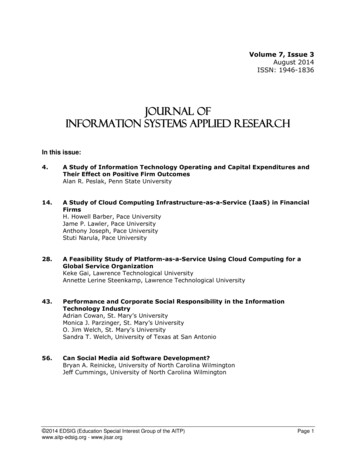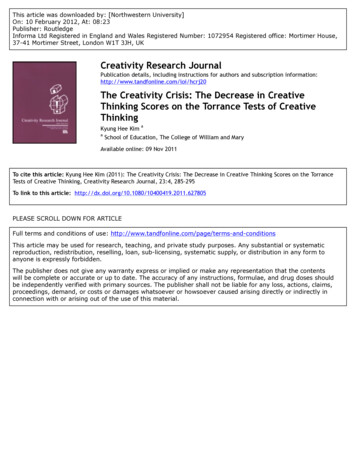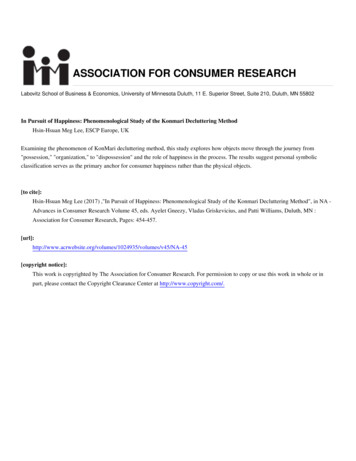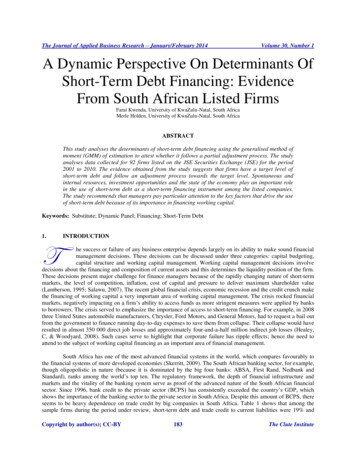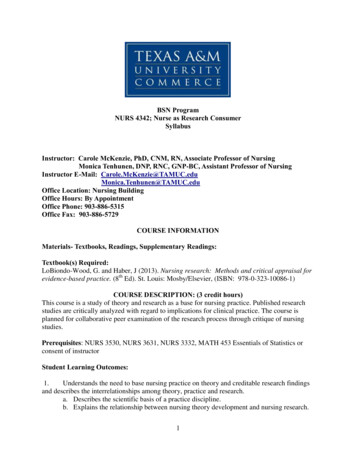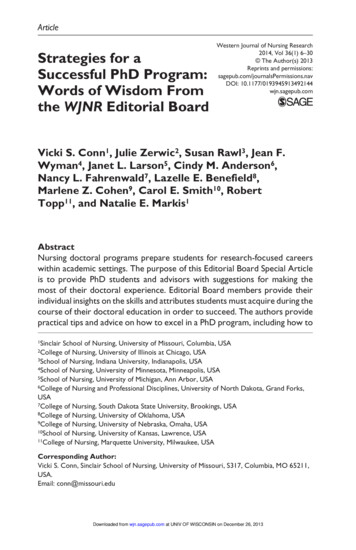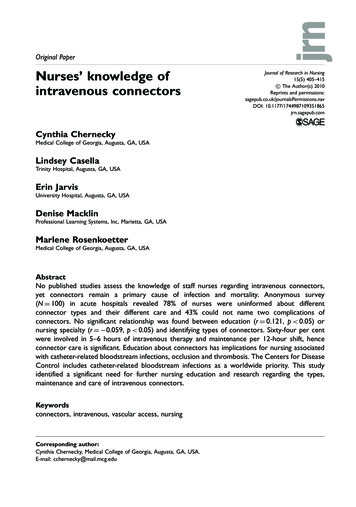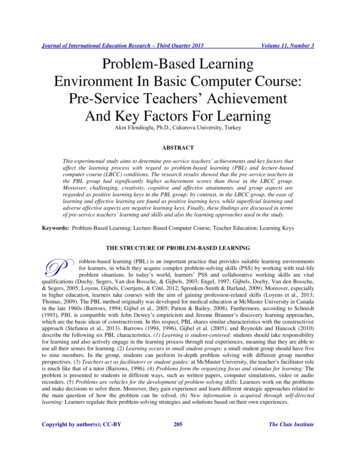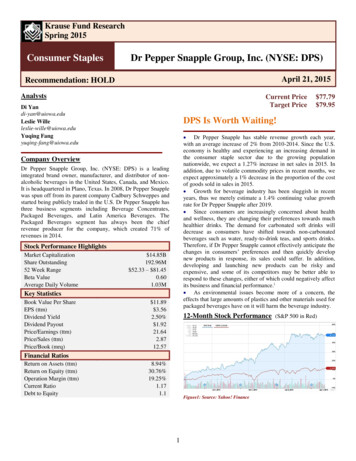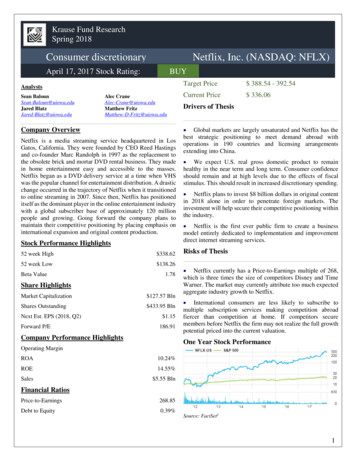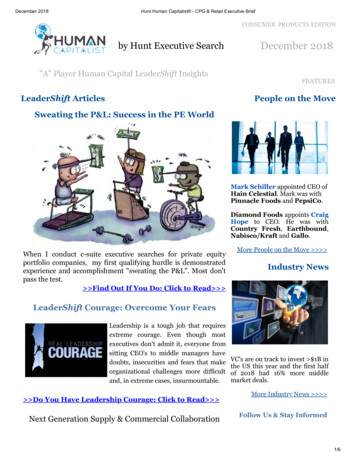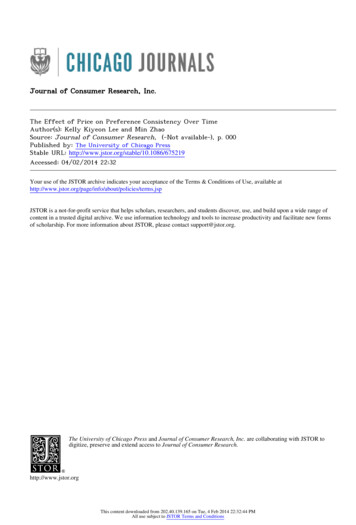
Transcription
Journal of Consumer Research, Inc.The Effect of Price on Preference Consistency Over TimeAuthor(s): Kelly Kiyeon Lee and Min ZhaoSource: Journal of Consumer Research, (-Not available-), p. 000Published by: The University of Chicago PressStable URL: http://www.jstor.org/stable/10.1086/675219 .Accessed: 04/02/2014 22:32Your use of the JSTOR archive indicates your acceptance of the Terms & Conditions of Use, available at ms.jsp.JSTOR is a not-for-profit service that helps scholars, researchers, and students discover, use, and build upon a wide range ofcontent in a trusted digital archive. We use information technology and tools to increase productivity and facilitate new formsof scholarship. For more information about JSTOR, please contact support@jstor.org.The University of Chicago Press and Journal of Consumer Research, Inc. are collaborating with JSTOR todigitize, preserve and extend access to Journal of Consumer Research.http://www.jstor.orgThis content downloaded from 202.40.139.165 on Tue, 4 Feb 2014 22:32:44 PMAll use subject to JSTOR Terms and Conditions
Please use DOI when citing. Page numbers are not final.The Effect of Price on PreferenceConsistency Over TimeKELLY KIYEON LEEMIN ZHAOConstrual level theory indicates that consumers tend to prefer products high indesirability (greater functionality) for distant-future decisions but switch their preferences toward products high in feasibility (greater usage convenience) for nearfuture decisions. The current research demonstrates that price information, traditionally considered as a feasibility cue, can increase consumers’ near-future preferencetoward products with greater functionality despite their low convenience, leadingto preference consistency over time. As the underlying mechanism, price information increases the functionality importance for near-future decisions due to consumers’ enhanced value-seeking tendency when seeing price and their lay beliefthat greater functionality represents higher value. Further, when consumers areled to believe that greater convenience represents higher value, price and thevalue-seeking tendency result in a greater preference toward easy-to-use productsfor the distant future and lead to preference consistency across time as well.Theoretical implications are discussed.Mthe software and ignores whether it is easy to use, thusordering the Adobe product with full capacity. However, asthe time to create the photo album draws near, ease of usebecomes top priority and the wide-ranging functionality ofthe software loses its importance. The consumer wishes hehad ordered the easier software.As this example illustrates, and as research on decisionsover time has indicated (Soman 2004; Tanner and Carlson2009; Trope and Liberman 2003; Zauberman and Lynch2005), consumers often display inconsistent preferencesover time when the decision involves trade-offs betweendesirability and feasibility: they choose options high in desirability for distant-future decisions but prefer options highin feasibility as the time of implementation draws near.These inconsistent preferences have been found to result innegative consequences such as regret, lower customer satisfaction, and failure to carry through with the earlier committed choices (Soman 2004; Zauberman and Lynch 2005).In the current research, we examine whether such preferenceinconsistency over time can be mitigated by price information, which we suggest increases consumers’ value-seeking tendency (Thaler 1985). Due to a prevalent lay beliefthat more features and greater functionality represent highervalue, this increased value-seeking tendency will shift consumers’ focus from the natural feasibility-related concerns(“Is this software package easy to use?”) to desirabilityrelated concerns (“Does this software package provide maximal functionality to get my money’s worth?”) for nearfuture decisions. Consequently, consumers increase theirany product choices involve trade-offs between desirability (i.e., functionality of a product) and feasibility (i.e., usage convenience). For example, consider aconsumer who is looking for a type of photo-editing software to create a photo album in 2 months. Adobe PhotoshopElements 10, a high-functionality option, provides a fullrange of image-editing features; however, it requires a greatdeal of effort to learn and use. CyberLink PhotoDirector2011, however, is easy to use with its simple interface andone-step installation process, but its image-editing featuresare limited. Because the consumer is choosing the softwarefor distant-future usage, he focuses on the functionality ofKelly Kiyeon Lee (kelly.lee@wustl.edu) is a postdoctoral fellow ofmarketing, Olin Business School, Washington University in St. Louis, OneBrookings Dr., Campus Box 1133, St. Louis, MO 63130. Min Zhao(min.zhao@rotman.utoronto.ca) is an associate professor of marketing,Rotman School of Management, University of Toronto, 105 St. GeorgeStreet, Toronto, ON M5S 3E6, Canada. Correspondence: Kelly KiyeonLee. The authors acknowledge the insightful input of the editor, the associate editor, and the three reviewers. In addition, the authors thank DilipSoman, Nina Mazar, Aparna Labroo, Claire Tsai, Stephen M. Nowlis, SelinA. Malkoc, Joseph K. Goodman, and Cynthia E. Cryder for helpful comments. Financial support from the Social Sciences and Humanities ResearchCouncil of Canada is greatly appreciated.Mary Frances Luce served as editor and Aimee Drolet Rossi served asassociate editor for this article.Electronically published January 14, 2014000䉷 2014 by JOURNAL OF CONSUMER RESEARCH, Inc. Vol. 41 June 2014All rights reserved. 0093-5301/2014/4101-0008 10.00. DOI: 10.1086/675219This content downloaded from 202.40.139.165 on Tue, 4 Feb 2014 22:32:44 PMAll use subject to JSTOR Terms and Conditions
JOURNAL OF CONSUMER RESEARCH000preference toward the high-functionality option in the nearfuture, which is consistent with their distant-future preference. For the distant future, because consumers naturallyfocus on product functionality, the effect of price information on desirability focus is redundant and does notchange preferences as much.In four experiments, we demonstrate the effect of priceinformation on preference consistency over time across various product choices involving functionality/conveniencetrade-offs. Further, we show a boundary condition whenindividuals are led to believe that greater convenience (ratherthan greater functionality) represents higher value. In closing, we discuss the theoretical implications of our findingsto choice over time and consumer heuristics and speculateon future research directions.THEORETICAL FRAMEWORKTime-dependent changes in choice and preference havebeen studied in interdisciplinary areas such as behavioraldecision making (Thaler 1981), self-control (Rachlin 1995),and delay of gratification (Mischel, Shoda, and Rodriguez1989). Whether temporal shifts have been explained by affective mechanisms (Loewenstein 1996) or by cognitivemechanisms (Liberman and Trope 1998; Trope and Liberman 2003; Zauberman and Lynch 2005), prior research hasconsistently demonstrated that consumers are more sensitiveto desirability when making distant-future decisions andmore sensitive to feasibility when making near-future decisions. This leads consumers to prefer options higher indesirability for the distant future, despite a low level offeasibility, and to shift their preference toward the highfeasibility options with lower desirability when the decisiondraws near. For example, research in construal level theory(CLT) has shown that people prefer interesting but difficultassignments for the distant future yet uninteresting but easyassignments for the near future (Liberman and Trope 1998),or people forecast stronger preferences for really new products (with novel functionalities but involving greater learning cost), yet they do not end up purchasing the new productswhen the products actually come to market (Alexander,Lynch, and Wang 2008). These inconsistent preferences overtime often lead to regret, lower customer satisfaction, orfailure to follow through with the earlier committed choices(Alexander et al. 2008; Soman 2004; the “Yes . . . Damn”effect, Zauberman and Lynch 2005).Given the frequency of preference inconsistency over timeand its potentially negative consequences, a substantial bodyof research has suggested different external aids that canhelp people attenuate preference inconsistency, includingpracticing distant-future tasks in full detail (Gollwitzer 1999;Trope and Liberman 2003), shifting attention away fromimmediate temptation (Hoch and Loewenstein 1991; Mischel et al.1989), and practicing different types of mentalsimulation (Zhao, Hoeffler, and Zauberman 2007). In thisinvestigation, we propose that the simple intervention ofhighlighting price information can shift consumers’ focusfrom feasibility to desirability for the near future, leadingto preference consistency over time. Although price is anessential marketplace cue that affects consumers’ way ofthinking and their purchase decisions, little research in CLThas directly investigated the effect of price on consumerpreference (Alexander et al. 2008; Trope and Liberman2003; Zhao et al. 2007), with the exception of Libermanand Trope (1998) where price was treated as a feasibilitycue (i.e., affordability) because it was a means toward theend (e.g., attending a concert).When being exposed to price information, how wouldconsumers react in making a choice between two optionsthat trade off functionality and convenience? Prior researchhas demonstrated that consumers have a strong tendency toseek value when they see price information (Hsee 1999;Thaler 1985; Yeung and Soman 2007). According to theMerriam-Webster Dictionary, value is defined as the monetary worth of something. When consumers think about howmuch they need to pay to obtain a product, they naturallythink about which option gives them the most value for theirmoney. In determining the monetary worth, consistent withpeople’s frequent usage of heuristics during judgment anddecisions (Tversky and Kahneman 1973, 1974), consumersare prompted to evaluate products on the basis of their (oftenirrationally) perceived values from a simplified heuristicrule, rather than carefully assessing product features andintegrating these assessments to form an economic evaluation (Yeung and Soman 2007). For example, prior researchhas shown that when exposed to price, consumers wouldprefer a physical training program with a longer durationover one with a shorter duration, or prefer a locksmith whotakes 20 minutes to unlock a door over a locksmith whodoes the job in 5 minutes, even if they are economicallyworse off with their preferred choice. That is, the longerduration scores low in convenience and actually means moreeffort or even a waste of time for their particular choices(Yeung and Soman 2007). In a similar vein, a recent studyshows that price prompts consumers to think about whethera product is worth the given price and increases the desireto purchase products with more functional benefits (Karmarkar 2010).According to these prior findings, we propose that whenprice information is provided in a scenario involving functionality/convenience trade-offs, consumers will increasetheir tendency to seek value for the money they need to pay.Since adding a (trivial) feature can lead consumers to inferthe feature’s value and an even greater valuation of the brand(Carpenter, Glazer, and Nakamoto 1994), and since eachadditional feature provides another reason for consumers topurchase a product by adding capability and thus perceivedvalue (Brown and Carpenter 2000), consumers’ value-seeking tendency leads them to focus on the benefits of havingmore features that lead to greater functionality, while ignoring whether it is convenient to use these features (Yeungand Soman 2007).On the basis of the reasoning above, we propose thatwhen price information is presented, because of consumers’increased tendency to seek value and their lay belief thatPlease use DOI when citing. Page numbers are not final.This content downloaded from 202.40.139.165 on Tue, 4 Feb 2014 22:32:44 PMAll use subject to JSTOR Terms and Conditions
LEE AND ZHAO000more features and greater functionality represent highervalue, they tend to focus on functionality of the productsand neglect usage convenience. When the product decisionis for the near future, this shift from a natural focus on thefeasibility aspect to the desirability aspect increases consumers’ preference for a high-functionality product. Whenthe product decision is for the distant future, a circumstancein which consumers naturally focus on desirability (Liberman and Trope 1998; Zauberman and Lynch 2005), theeffect of price information is redundant; thus, price information does not catalyze a change in preference (Zhao etal. 2007). As a result, we hypothesize that price informationincreases preference for high-functionality products for thenear future and induces preference consistency over time.Below, we report four experiments that were designed totest our hypothesis and the important role of consumers’ laybelief about value.EXPERIMENT 1To examine how price information can affect consumers’preference consistency over time, we selected real marketplace products and their prices in this experiment. We chosetwo digital cameras from the same brand (Nikon) that involve trade-offs between product functionality and usageconvenience. One digital camera (Nikon Coolpix P510) provides greater functionality with rich features but is moredifficult to use, whereas the other digital camera (NikonCoolpix S9300) provides fewer features but is superior inusage convenience. The price of the high-functionality option ( 429.99) is higher than the price of the high-convenience option ( 349.99). According to CLT (Liberman andTrope 1998), for the dist
highlighting price information can shift consumers’ focus from feasibility to desirability for the near future, leading to preference consistency over time. Although price is an essential marketplace cue that affects consumers’ way of thinking and their purchase decisions, little research in CLT

